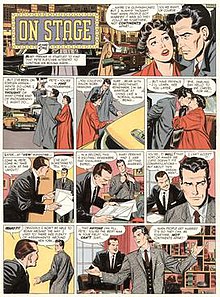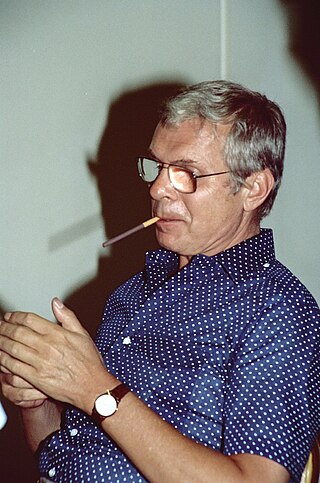
Leonard Starr was an American cartoonist, comic book artist, and advertising artist, best known for creating the newspaper comic strip On Stage and reviving Little Orphan Annie.
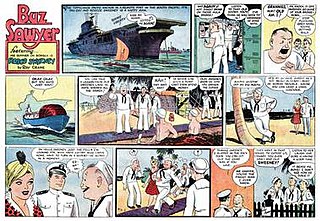
Buz Sawyer is a comic strip created by Roy Crane. Distributed by King Features Syndicate, it had a run from November 1, 1943 to October 7, 1989. The last strip signed by Crane was dated 21 April 1979.

Jane Arden was an internationally syndicated daily newspaper comic strip which ran from November 26, 1928 to January 20, 1968. The title character was the original "spunky girl reporter", actively seeking to infiltrate and expose criminal activity rather than just report on its consequences and served as a prototype for later characters such as Superman supporting character Lois Lane and fellow comic strip heroine Brenda Starr, Reporter. Pulitzer Prize-winning columnist Mary McGrory credited Jane Arden with instilling her interest in journalism.
United Feature Syndicate, Inc. (UFS) is a large American editorial column and comic strip newspaper syndication service based in the United States and established in 1919. Originally part of E. W. Scripps Company, it was part of United Media from 1978 to 2011, and is now a division of Andrews McMeel Syndication. United Features has syndicated many notable comic strips, including Peanuts, Garfield, Li'l Abner, Dilbert, Nancy, and Marmaduke.

The Funnies is the name of two American publications from Dell Publishing, the first of these a seminal 1920s precursor of comic books, and the second a standard 1930s comic book.

Jungle Jim is the fictional hero of a series of jungle adventures in various media. The series began on January 7, 1934, as an American newspaper comic strip chronicling the adventures of Asia-based hunter Jim Bradley, who was nicknamed Jungle Jim. The character also trekked through radio, film, comic book and television adaptations. Notable was a series of films and television episodes in which Johnny Weissmuller portrayed the safari-suit wearing character, after hanging up his Tarzan loincloth. The strip concluded on August 8, 1954.
The Alley Award was an American annual series of comic book fan awards, first presented in 1962 for comics published in 1961. Officially organized under the aegis of the Academy of Comic Book Arts and Sciences, the award shared close ties with the fanzine Alter Ego magazine. The Alley is the first known comic book fan award.
Star Hawks was a comic strip created by Ron Goulart and Gil Kane, first published on October 3, 1977, that ran through May 2, 1981. It was written through April 1979 by Goulart, followed by Archie Goodwin (1979-1980), Roger McKenzie (1980-1981) and Roger Stern. Comics veteran Gil Kane provided the artwork, with uncredited help from Ernie Colón and Howard Chaykin.

Funnies on Parade is an American giveaway publication of 1933 that was a precursor of comic books. The eight-page publication featured reprints of such popular syndicated comic strips as The Bungle Family, Joe Palooka, Keeping Up with the Joneses, Mutt and Jeff, Reg'lar Fellers, and Somebody's Stenog. Creators included F. O. Alexander, Gene Byrnes, Al Capp, Clare Victor Dwiggins, A. E. Hayward, C. M. Payne, Al Smith, and Harry J. Tuthill.
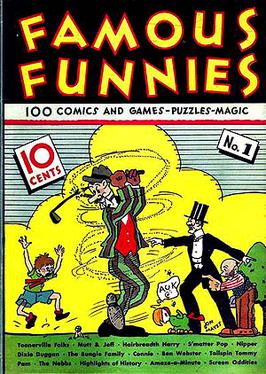
Famous Funnies is an American comic strip anthology series published from 1934 to 1955 with two precursor one-shots appearing in 1933–1934. Published by Eastern Color Printing, Famous Funnies is considered by popular culture historians as the first true American comic book, following seminal precursors.
Good Time Guy is a humorous syndicated comic strip that was distributed by Metropolitan Newspaper Service from June 27, 1927 to December 6, 1930.
Baron Bean is a newspaper comic strip created by the cartoonist George Herriman. Baron Bean was distributed by King Features Syndicate.
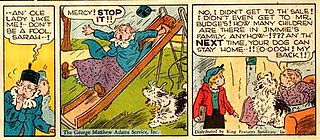
Cap Stubbs and Tippie is a syndicated newspaper comic strip created by the cartoonist Edwina Dumm that ran for 48 years, from August 21, 1918, to September 3, 1966. At times the title changed to Tippie & Cap Stubbs or Tippie.
A comic strip syndicate functions as an agent for cartoonists and comic strip creators, placing the cartoons and strips in as many newspapers as possible on behalf of the artist. A syndicate can annually receive thousands of submissions, from which only two or three might be selected for representation. In some cases, the work will be owned by the syndicate as opposed to the creator. The Guinness World Record for the world's most syndicated strip belongs to Jim Davis' Garfield, which at that point (2002) appeared in 2,570 newspapers, with 263 million readers worldwide.

The McNaught Syndicate was an American newspaper syndicate founded in 1922. It was established by Virgil Venice McNitt and Charles V. McAdam. Its best known contents were the columns by Will Rogers and O. O. McIntyre, the Dear Abby letters section and comic strips, including Joe Palooka and Heathcliff. It folded in September 1989.
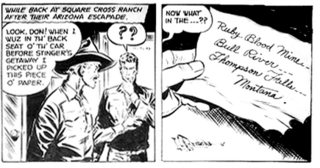
Don Winslow of the Navy is an American comic strip created by Frank Victor Martinek and was distributed mostly by the Bell Syndicate from 1934 to 1955. The title character was a spy-chasing lieutenant commander in Naval intelligence. The comic strip led to a radio adventure serial that began in 1937, as well as film serials that began in 1942. Original comic book stories also appeared in Fawcett Comics titles starting in 1943.
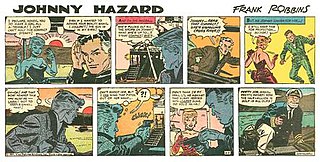
Johnny Hazard is an action-adventure comic strip created by cartoonist Frank Robbins for King Features Syndicate. It was published from June 5, 1944, until August 20, 1977, with separate storylines for the daily strip and the Sunday strip.
Twin Earths is an American science fiction comic strip written by Oskar Lebeck and drawn by Alden McWilliams that ran in Sunday and daily newspapers from 1952 until 1963. The strip was distributed by United Feature Syndicate.
The Bell Syndicate, launched in 1916 by editor-publisher John Neville Wheeler, was an American syndicate that distributed columns, fiction, feature articles and comic strips to newspapers for decades. It was located in New York City at 247 West 43rd Street and later at 229 West 43rd Street. It also reprinted comic strips in book form.
Associated Newspapers, Inc. was a print syndication service of columns and comic strips that was in operation from 1912 to c. 1966. The syndicate was originally a cooperative of four newspapers: The New York Globe, the Chicago Daily News, The Boston Globe, and the Philadelphia Bulletin. Associated Newspapers was led by Henry Herbert McClure (1874-1938), a cousin of S. S. McClure, founder of the McClure Syndicate, the first American newspaper syndicate. In 1930, Associated Newspapers was acquired by and became a subsidiary of the Bell Syndicate. The syndicate's most successful, long-running strip was Gladys Parker's Mopsy.
